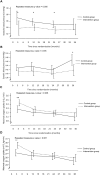A 3-year randomized trial of lifestyle intervention for cardiovascular risk reduction in the primary care setting: the Swedish Björknäs study
- PMID: 19365563
- PMCID: PMC2664964
- DOI: 10.1371/journal.pone.0005195
A 3-year randomized trial of lifestyle intervention for cardiovascular risk reduction in the primary care setting: the Swedish Björknäs study
Abstract
Background: Successfully transferring the findings of expensive and tightly controlled programmes of intensive lifestyle modification to the primary care setting is necessary if such knowledge is to be of clinical utility. The objective of this study was to test whether intensive lifestyle modification, shown previously in tightly-controlled clinical trials to be efficacious for diabetes risk-reduction among high-risk individuals, can reduce cardiovascular risk factor levels in the primary care setting.
Methodology / principal findings: The Swedish Björknäs study was a randomized controlled trial conducted from 2003 to 2006 with follow-up on cardiovascular risk factors at 3, 12, 24 and 36 months. A total of 151 middle-aged men and women at moderate- to high-risk of cardiovascular disease from northern Sweden were randomly assigned to either an intensive lifestyle intervention (n = 75) or control (n = 76) group. The intervention was based broadly on the protocol of the Diabetes Prevention Program. The three-month intervention period was administered in the primary care setting and consisted of supervised exercise sessions and diet counselling, followed by regular group meetings during three years. The control group was given general advice about diet and exercise and received standard clinical care. Outcomes were changes in anthropometrics, aerobic fitness, self-reported physical activity, blood pressure, and metabolic traits. At 36 months post-randomisation, intensive lifestyle modification reduced waist circumference (-2.2 cm: p = 0.001), waist-hip ratio (-0.02: p<0.0001), systolic blood pressure (-4.9 mmHg: p = 0.036), and diastolic blood pressure (-1.6 mmHg: p = 0.005), and improved aerobic fitness (5%; p = 0.038). Changes in lipid or glucose values did not differ statistically between groups. At 36 months, self-reported time spent exercising and total physical activity had increased more in the intervention group than in the control group (p<0.001).
Conclusion / significance: A program of intensive lifestyle modification undertaken in the primary health care setting can favourably influence cardiovascular risk-factor profiles in high-risk individuals.
Trial registration: ClinicalTrials.gov NCT00486941.
Conflict of interest statement
Figures





References
-
- Bassuk S, Manson J. Epidemiological evidence for the role of physical activity in reducing risk of type 2diabetes and cardiovascular disease. J Appl Physiol. 2005;99:1193–1204. - PubMed
-
- Mozaffarian D, Wilson P, Kannel W. Beyond established and novel risk factors. Circulation. 2008;117:3031–3038. - PubMed
-
- Yusuf S, Hawken S, Ounpuu S, Bautista L, Franzosi M, et al. on the behalf of the INTERHEART Study Investigators. Obesity and the risk of myocardial infarction in 27 000 participants from 52 countries: a case control study. Lancet. 2005;366:1640–1649. - PubMed
Publication types
MeSH terms
Associated data
LinkOut - more resources
Full Text Sources
Medical

